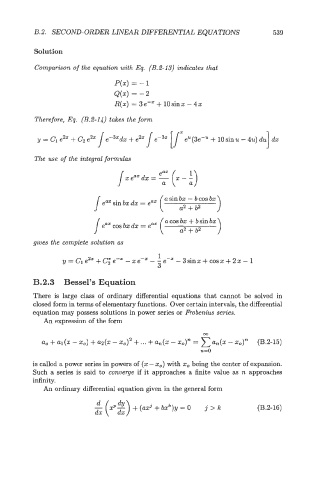Page 559 - Modelling in Transport Phenomena A Conceptual Approach
P. 559
B.2. SECOND-ORDER LINEAR DIFFERENTIAL EQUATIONS 539
Solution
Comparison of the equation with Eq. (B.2-13) indicates that
P(x) = -1
Q(x) = -2
R(x) = 3e-" + 10sinx - 4x
Therefore, Eq. (B.2-14) takes the form
3
y = CI e2x + C2 e2r 1 e-3xdx + e2s / e-3s [ Is eu(3e-u + 10 sin u - 4u) du dx
The use of the integral fornaulm
asinbx - bcosbx
J eax sin bx dx = eas
J eax cos bx dx = eax acosbx+ bsinbx
gives the complete solution as
B.2.3 Bessel's Equation
There is large class of ordinary differential equations that cannot be solved in
closed form in terms of elementary functions. Over certain intervals, the differential
equation may possess solutions in power series or hbenius series.
An expression of the form
00
a, + al(x - 2,) + u2(x - x,)~ + ... + an(x - z,)~ = un(x - zo)n (B.Zl5)
n=O
is called a power series in powers of (z - x,) with x, being the center of expansion.
Such a series is said to converge if it approaches a finite value as n approaches
infinity.
An ordinary differential equation given in the general form
(B.2-16)

